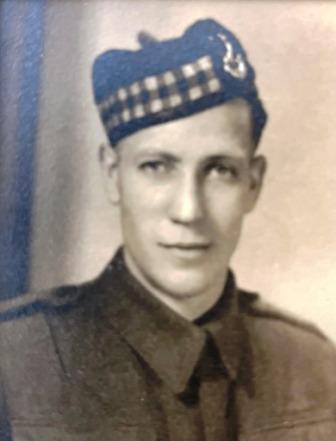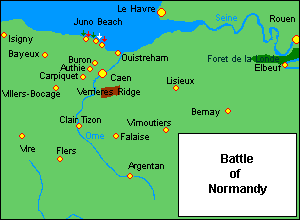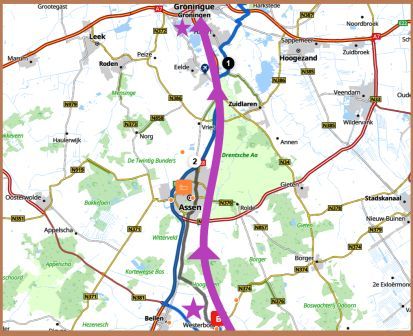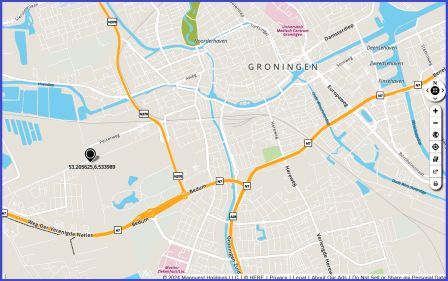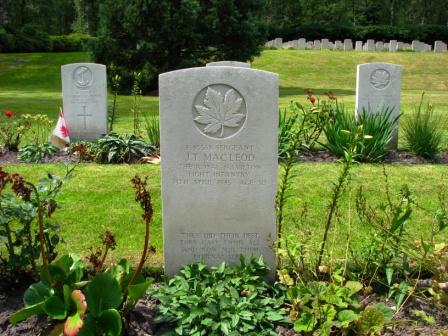April 18, 2024. In August 2019, Alice van Bekkum, Chair of the Faces To Graves Foundation Groesbeek, sent Pieter a list of soldiers from Prince Edward Island who are buried in the Canadian War Cemetery in Groesbeek, The Netherlands.
One of the names for which a photo was missing was that of Ralph Kenneth SILLIKER, born October 16, 1917 in O’Leary, Prince Edward Island, the son of Watson and Ruth Silliker.
Pieter began his research and within a few weeks received a photo from Watson Silliker, Ralph’s nephew.
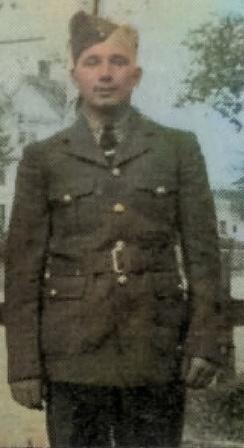
Ralph Kenneth Silliker. (Photo courtesy of Watson Silliker. Photo colourization by Pieter Valkenburg)
….Ralph’s working life began in childhood….
It soon became clear that Ralph’s working life began in childhood. His father Watson had began the first oil delivery business in 1922, according to ‘Threads of the past: a history of O’Leary, Prince Edward Island, 1837-1922’, published by the O’Leary Women’s Institute.
“…The Silliker family – Watson, Ruth, and their children Ralph, Iva, Lloyd, and Lorne – manually pumped the kerosene and gasoline from the railway tank cars, which held over 8,000 gallons each, into the storage tanks….”
This was not an easy business to be in! “….By truck in summer and sleigh in winter, sparse quantities of gasoline and liberal quantities of kerosene in 45 gallon drums were delivered to stores and homes around the countryside….”
The entry in the O’Leary history went on to note that “….when Ralph was eight years old, he drove a team of horses to places such as Portage, Glenwood, Campbelltown, and Bloomfield...”
….Ralph enlisted in 1943….
When he enlisted with the No. 6 District Depot in Charlottetown, Prince Edward Island on May 13, 1943, Ralph was working as a truck driver in O’Leary, and was married. He and his wife Ada Blanche were the parents of two daughters, Sylvia Ruth and Opal Irene.
Ralph was sent for basic training at No. 62 Canadian Army Basic Training Centre (CABTC) in Charlottetown, Prince Edward Island. On August 14, 1943, he was seconded to the A27 Canadian Reconnaissance Training Centre – Camp Dundurn, in Dundurn, Saskatchewan. This was a major training centre and transit point for personnel going overseas.
However, not long after arriving at Camp Dundurn, he returned to Prince Edward Island after being granted ‘compassionate family leave’ on September 7, 1943 – without pay and allowance – until December 14, 1943. In October 1943 he had been transferred to ‘P’ Wing at the No. 6 District Depot in Halifax, Nova Scotia, but due to the compassionate family leave being extended twice he was not on duty in Halifax until his leave ended.
Ralph returned to A27 Canadian Reconnaissance Training Centre in Camp Dundurn on January 11, 1944, where his training resumed. On March 31, 1944 he qualified as a Driver Wheeled Class III. This meant he was qualified to drive heavy trucks and armoured cars.
….Ralph left Canada for overseas service….
In May 1944 Ralph was given embarkation leave, the last time he would see his family, as on June 27, 1944 he was on his way to the United Kingdom. Upon arrival on July 3, 1944, he was assigned to No. 1 Canadian Armoured Corps Reinforcement Unit (CACRU).
On August 12, 1944, Ralph was assigned to the Canadian Infantry Corps (CIC) as part of the Canadian Fusiliers and his position changed from trooper to fusilier. On September 17, 1944, Ralph embarked for France as part of X-4 Reinforcement list of the Canadian Infantry Corps.
….Ralph was assigned to the Lake Superior Regiment….
On October 7, 1944 he was transferred to the Lake Superior Regiment (Motor), part of the 21st Army Group, joining them as the Regiment advanced through France, Belgium and the south of the Netherlands.
Ralph was in the Regiment at the same time as Harry DAVIS of Yukon Territory, whose story has previously been told. See https://onthewarmemorialtrail.com/2023/09/30/on-the-war-memorial-trail-the-only-yukon-territory-soldier-buried-in-holten/
Henk Vincent, one of the research volunteers at the Cemetery Information Centre in Holten, The Netherlands, explained that during the “… the winter of 44/45, the Lake Superior Regiment, together with other Canadian regiments, was tasked with guarding the northern front line, in this case the Maas River. ….”
Most of February saw the Regiment based in the ‘s-Hertogenbosch area as they continued their patrols in the surrounding area.
….The Battle of Hochwald Gap was a fierce tank battle….
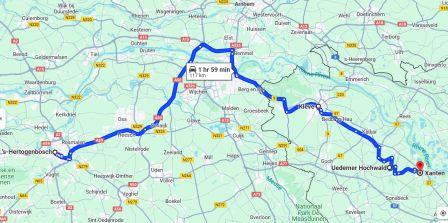
Map shows location of ‘s-Hertogenbosch, Kleve, Hochwald, Xanten, and Groesbeek. (Map source: https://www.google.ca)
On February 21, 1945, the Regiment began moving towards Germany for the upcoming Operation Blockbuster, which would begin at dawn on February 26, 1945. (See https://en.wikipedia.org/wiki/Operation_Blockbuster)
The February 21, 1945 war diary entry noted that “…in the afternoon the men were told of our future role and intentions in Ops Blockbuster….”
On February 22, 1945, the war diary recorded that “…the companies spent the day making final preparations for the move into Germany tonight…” By 2:00 am in the early morning of February 23, 1945 the Regiment had arrived at their initial position in the Reichswald Forest, just over the border from The Netherlands. The next afternoon the Regiment moved to Kleve.
On March 1, 1945, the war diary for the Lake Superior Regiment recorded that instructions had been received for “…the assault on the Hochwald Forest Gap….” This attack was codenamed Operation Churchill.
Clearing the very narrow Hochwald Gap was a difficult task, given that the weather was anything but cooperative. An early thaw meant that the tanks got bogged down in mud, making them ‘sitting ducks’ for German troops who were positioned to pick them off, one by one. Troops had no choice but to press on, as the Battle of Hochwald Gap, part of Operation Blockbuster, was the final push towards the Rhine River. (See https://the-hochwald-gap.project44.ca/)
….A video shows how the Battle of Hochwald Gap was fought….
A 46 minute YouTube video on the Battle of Hochwald Gap explained the fierce battle that took place. Watching it made it clear to us that it was a miracle that anyone survived at all, a testament to the determination and courage of those who were in the midst of it.
….Ralph lost his life during Operation Churchill….
March 2, 1945 was a “…cold, blustery day with several snow flurries…” according to the war diary. The after-action report on Operation Churchill noted that the Regiment “…had been fighting already since the 26th of February. Little sleep was had and the Motor Companies had been holding the general line for 24 hours without food….”
They’d last eaten on February 28 due to the ground being “…impassable to all vehicles…” and “…incessant shelling by the enemy….”
The men may have been tired, cold, and hungry, but there was still a battle to be fought. By the end of the day, “…the south of the Gap bore the signs of intense shellfire – the ground pitted, scarred, and torn by fire of all kinds. The trees in the gully were cut to ribbons. The houses were heaps of rubble….”
A burial party the following day went out onto the battlefield to look for casualties, and recorded how they were found. “…Further back where two Kangaroos had been knocked out as they lunged across an enemy trench, two more Lake Superior men lay dead. Pte Carriere, F. had been shot through the head as he was de-bussing. Another, Pte Silliker, R. K. was killed as he raced to take up the first position…..” Dutiful and responsible to the end, Ralph lost his life at the age of 27 during the March 2, 1945 battle.
Private Frank CARRIERE was the son of Emma Carriere of Elm Creek, Manitoba, and the brother of Rifleman William Joseph CARRIERE, who had lost his life on June 8, 1944 while serving with the Royal Winnipeg Rifles.
NOTE: Kangaroo is the nickname given to a Canadian armoured personnel carrier (APC) during the WWII, which was created by converting a tank chassis. (See https://en.wikipedia.org/wiki/Kangaroo_(armoured_personnel_carrier))
….Ralph is buried in the Canadian War Cemetery in Groesbeek….
Ralph was temporarily buried on March 6, 1945 in Xanten, Germany before being reburied in the Canadian War Cemetery in Groesbeek, The Netherlands.
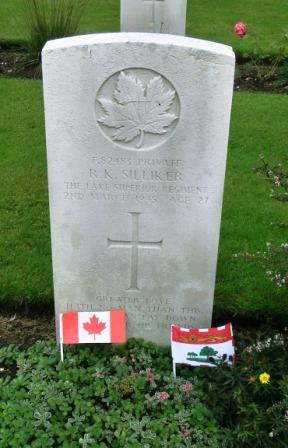
Grave of Ralph Kenneth Silliker in the Canadian War Cemetery in Groesbeek, The Netherlands. (Photo credit: Daria Valkenburg)
Thank you to Watson Silliker for sharing a photo. Thank you also to Henk Vincent for additional information on the patrols made along the Maas River. Do you have photos or information to share? Email Pieter at memorialtrail@gmail.com, comment on the blog, or tweet to @researchmemori1.
© Daria Valkenburg
….Want to follow our research?….
If you are reading this posting, but aren’t following our research, you are welcome to do so. Our blog address: https://onthewarmemorialtrail.com/
 4 countries, 6 weeks, 7,000 km – an unforgettable war memorial journey in Europe…. Daria’s book ‘No Soldier Buried Overseas Should Ever Be Forgotten‘ is available in print and e-book formats. Net proceeds of book sales help support research costs and the cost of maintaining this blog. For more information see https://nosoldierforgotten.com/
4 countries, 6 weeks, 7,000 km – an unforgettable war memorial journey in Europe…. Daria’s book ‘No Soldier Buried Overseas Should Ever Be Forgotten‘ is available in print and e-book formats. Net proceeds of book sales help support research costs and the cost of maintaining this blog. For more information see https://nosoldierforgotten.com/
You are also invited to subscribe to our YouTube Channel: On The War Memorial Trail With Pieter Valkenburg: https://www.youtube.com/channel/UCJ591TyjSheOR-Cb_Gs_5Kw.
Never miss a posting! Subscribe below to have each new story from the war memorial trail delivered to your inbox.

